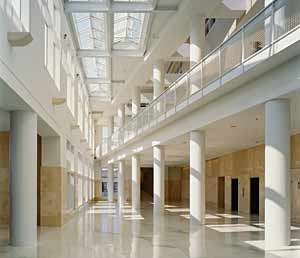Exploring the High-Performance Benefits of Laminated Glass
Versatile Building Material Provides Multiple Advantages
This course is no longer active
A system may also need to pass additional tests such as air
and water infiltration, structural load and forced-entry resistance
to comply with some building code requirements.
|
Extreme
Wind & Impact - Glass Constructions
|
|
Missile
|
Code/Standard
|
Glass Configuration
|
|
Large
|
FBC TAS 201/3 Dade
|
Glass-2.29-mm (0.090")
PVB*-Glass
|
|
Large
|
SBCCI Apdx SSTD-12
|
Glass-2.29-mm (0.090")
PVB*-Glass
|
|
Large
|
ASTM E1996
|
Glass-2.29-mm (0.090")
PVB*-Glass
|
|
Small
|
FBC TAS 201/3 Dade
|
Glass-1.52-mm (0.060")
PVB*-Glass
|
|
Small
|
SBCCI Apdx SSTD-12
|
Glass-1.52-mm (0.060")
PVB*-Glass
|
|
Small
|
ASTM E1996
|
Glass-2.29-mm (0.090")
PVB*-Glass
|
|
*Typical gauge interlayer
for indicated performance - thinner gauge
in standard product and PVB interlayer may
pass the same requiments
|
|
Typical
Standards for Windborne Debris Impact Tests
|
|
|
Properly designed window and door systems manufactured with
laminated glass have proven successful in meeting major building
codes and test standards such as the Florida Building Code,
including the High Velocity Wind Zone (Dade County); International
Building Code; ASTM and Texas Department of Insurance. While
certain other protection methods such as storm shutters also
meet many standards, laminated glass offers continuous passive
protection to a building's structure, contents, and inhabitants
without the need for storing and properly installing unwieldy
shutters or storm screens.

Dan M. Russell
Jr. United States Federal Courthouse, Gulfport,
Mississippi.
Architect: R. M. Kliment + Frances Halsband
Architects
Photo: © Cervin Robinson, 2005 |
|
|
Originally published in Architectural Record.
Originally published in January 2005










